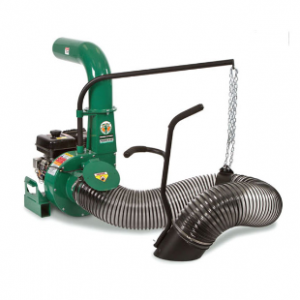 Your debris loader’s impeller goes through a lot to pick up lawn waste and turn it into easily compostable, disposable material. If your machine performs poorly, wants to stall, or vibrates violently, the impeller might be damaged. Here’s how you can inspect and repair this important part of your Billy Goat truck loader.
Your debris loader’s impeller goes through a lot to pick up lawn waste and turn it into easily compostable, disposable material. If your machine performs poorly, wants to stall, or vibrates violently, the impeller might be damaged. Here’s how you can inspect and repair this important part of your Billy Goat truck loader.
Safety
The impellers used in these loaders are made from thick steel and have serrated edges to chop up leaves. That means they’re sharp and heavy. Always wear thick gloves when working on your debris loader.
Before working on your equipment, disconnect the spark plugs. The impeller connects directly to the crankshaft, so turning it may be enough to start the engine.
What Does This Part Do?
The impeller has two roles in your debris loader.
Fan: The blades spin at high speeds, moving air and debris. Suction at the front of the chamber pulls debris through the hose, while pressure on the chamber edges pushes debris up through the chute. The plates’ flat shape may not be the best for airflow, but this lets them physically push debris through the system.
Shredder: Breaking apart and compacting leaves saves space, letting you haul more debris and pay less for disposal costs. Smaller pieces are also easier to compost, which is better for recycling and on-site reclamation. To shred material as much as possible, Billy Goat separates their impellers into two sections. The star-shaped Piranha Blade has 5 serrated edges that break apart leaves as soon as they enter the chamber. The plates on the main impeller have less aggressive blades to finish the job. Together, these parts can reduce debris up to 12:1.
Accessing the Impeller
Billy Goat truck loaders have a bolt-on plate that covers the front side of the impeller housing. After shutting off the engine and disconnecting the plugs, disconnect the hose, then remove the bolts or lock nut holding the intake plate onto the housing. Be careful moving the plate: the safety kill switch for the hose has a wire leading to the engine. Either set the plate to the side, keeping some slack on the wire, or disconnect the switch from the wiring harness.
Addressing Poor Performance
Most clogs happen inside the hose. However, sticks, rocks, and other debris can make their way into the impeller chamber, wedging between components or blocking airflow. Clean out the chamber, then check the front and back sides of the crankshaft for wound up grass, cutting it away as needed.
Larger models have a wear plate surrounding the sides of the chamber. As it wears down, this plate increases the gap between the impeller and housing. This reduces the vacuum.
Damaged teeth on the Piranha Blade or the impeller will keep the machine from effectively breaking down debris. These teeth should not be sharpened, as this can throw the impeller out of balance.
Bent and cracked parts will throw the machine out of balance, causing poor suction and vibrations that are hard on the engine and bearings. Replace these parts as needed.
Can I Weld a Cracked Impeller?
No. When the engine is on, the impeller is spinning at 2,000 to 3,000 RPM. That means the impeller needs to be carefully balanced to prevent engine damage or contact with the housing. Using a welded impeller risks major damage to your equipment and injury to those using it.
Removing and Installing the Impeller
Always use a new bolt and washer when fitting the impeller. These parts stretch when tightened down, and reuse may lead to failure. Replacement fasteners are included with new impellers, or they can be ordered separately.
To remove the bolt, you’ll need an impact wrench. The hammering action loosens the bolt without spinning the unit. With the bolt removed, the impeller should slide off of the driveshaft. If it doesn’t, apply penetrating oil to the shaft and pry against the hub. Prying against the plates can bend them, ruining the impeller.
When fitting the impeller, be sure to tighten down the bolt with a torque wrench. The recommended torque varies depending on your model:
DL14 and DL18 – 33-38 ft-lbs.
DL25 – 60 ft-lbs.
DL35, DL37 and DL39 – 175-180 ft-lbs.
Get Everything You Need Without Leaving Your Computer
Do you need parts for your Billy Goat equipment? Visit www.billygoatparts.com. We’re not just an online retailer: we’re an authorized dealer for Billy Goat and their partners including Honda Engines and Briggs & Stratton. That means we carry OEM replacements for everything on your equipment. We have a section of our website dedicated to impeller parts, or you can search by looking at factory diagrams for your equipment. We ship across the United States and Canada.
